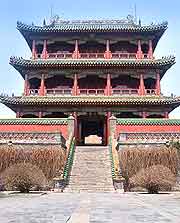Shenyang History Facts and Timeline
(Shenyang, Liaoning, China)

The biggest city in China's north-eastern Liaoning province is Shenyang, a Manchu capital during the 17th century that has grown into one of the most diverse and economically important centres in modern China.
It's a major hub for this lively corner of the country, boasting abundant natural resources, good transportation networks and a highly skilled local workforce.
Manchu Glory Days
The history of Shenyang had its golden era during the reign of the Manchus, in the early 1600s. When General Nurhaci defeated the ruling Ming Dynasty, he tipped the city as the capital of a new China. At the time, however, the city was largely known as Mukden, which remains the present day Manchu name for Shenyang.
To give his new capital an air of power, Nurhaci built the Shenyang Imperial Palace in 1625. Fashioned after Beijing's Forbidden Palace, this impressive compound is today part of a UNESCO World Heritage site. But even this grandiose palace could not keep the Manchus happy, and in 1644 the ruling party moved its base of operations to
Beijing, transforming itself into the Qing Dynasty that ruled China until 1911.
Regional Conflicts
Things began to go badly for the Qing Dynasty in the late 1800s when regional tempers flared over control of the Korean Peninsula. The First Sino-Japanese War of 1894 and 1895 saw China lose much of its territory in the Liaoning province, and forced it to concede control of nearby
Dalian and Port Arthur to the Japanese.
Russia was also very interested in the coastal city of Dalian as an ice-free winter port. It signed a deal with China in 1898 that allowed for a 25-year Russian lease on Dalian. However, Russian control came to an end in 1905 when Russia was defeated in the Russo-Japanese War.
History of Japanese Occupation
The Russo-Japanese War of 1904 and 1905 put Shenyang in the heart of the fighting with the Battle of Mukden. This major 1905 battle brought victory to the Japanese, who in turn took control of Shenyang and turned it into one of its main bases for economic expansion into southern Manchuria.
During this period, Shenyang enjoyed a lot of development thanks to Russian money and influence. The city was connected to other parts of China by rail and its port thrived, turning it into one of Asia's biggest manufacturing centres.
The history of Shenyang in the early part of the 20th century saw heavy expansion as the city became built up outside its old city walls. Ammunition factories sprang up in the countryside surrounding the city, laying the foundation for today's industrial powerhouse as we know it, and the ever-expanding railway kept Shenyang well connected to the rest of China.
Arrival of the Modern Face
Japan was largely responsible for creating the industrial city of Shenyang that exists today, but in 1945 it lost control of everything in the wake of WWII. Soviet forces were the first to move in, but were quickly replaced by Chinese forces with the backing of the United States.
During the Chinese Civil War (1927 to 1949 / 1950), Shenyang was one of the Kuomintang's main bases of operations between 1946 and 1948. When the Communist forces captured the city in 1948, the city finally ended its see-saw of foreign occupation. It has continued, over the decades, to grow into one of China's main industrial hubs.
 The biggest city in China's north-eastern Liaoning province is Shenyang, a Manchu capital during the 17th century that has grown into one of the most diverse and economically important centres in modern China.
The biggest city in China's north-eastern Liaoning province is Shenyang, a Manchu capital during the 17th century that has grown into one of the most diverse and economically important centres in modern China.